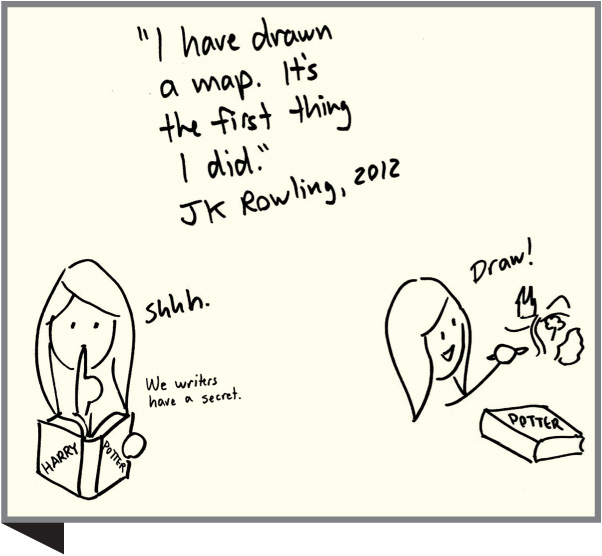Foreword
Writing has a dirty little secret. Authors don’t admit it, editors deny it, and publishers repress it. This secret is so explosive that if ever exposed, it would bring the literary world to its knees. Or so the literary world believes. Want to know what the secret is? Pictures.
For 32,000 years, people have drawn. We’ve written for only 5,000. (And since the first written languages were pictorial, even that date is debatable.)
Let me share a few data points:
 J.K. Rowling, the most successful author of our generation, finally
admitted two years ago that she drew Harry Potter’s world before
she wrote it.
J.K. Rowling, the most successful author of our generation, finally
admitted two years ago that she drew Harry Potter’s world before
she wrote it.
 J.R.R. Tolkien drew Middle Earth before writing of it. The Lord
of the Rings was originally intended to be illustrated, but
his publisher said no. (His books of drawings became available only
after the success of Peter Jackson’s movies.)
J.R.R. Tolkien drew Middle Earth before writing of it. The Lord
of the Rings was originally intended to be illustrated, but
his publisher said no. (His books of drawings became available only
after the success of Peter Jackson’s movies.)
 Before he wrote On the Road, Jack Kerouac drew a mandala
to visualize his plotlines.
Before he wrote On the Road, Jack Kerouac drew a mandala
to visualize his plotlines.
 Joseph Heller created a visual timeline to
help keep track of the action in Catch 22.
Joseph Heller created a visual timeline to
help keep track of the action in Catch 22.
 Vladimir Nabokov had to create a map of James Joyce’s
Ulysses in order to follow the narrative.
Vladimir Nabokov had to create a map of James Joyce’s
Ulysses in order to follow the narrative.

The list goes on. As students of literature and imagination, did we ever know this?
We did not. Strange, isn’t it? Pictures are the basis of our storytelling, but no one seems to want to admit it.
Our verbal mind does not work without our visual mind. Those of us raised in the western educational tradition find that terrifying. Pictures trivialize, drawings are silly, doodles patronize, art is decoration. These are the things we’re told in school.
In this marvelous book, Ekaterina Walter and Jessica Gioglio show us how wrong we are.
Thinking in pictures is our nature. Sharing those pictures has long been our dream. With the arrival of global social media, we have a whole new set of tools to make that dream come true.
Thank you, Ekaterina and Jessica, for showing us those tools. This is going to be fun.
DAN ROAM
San Francisco, 2013